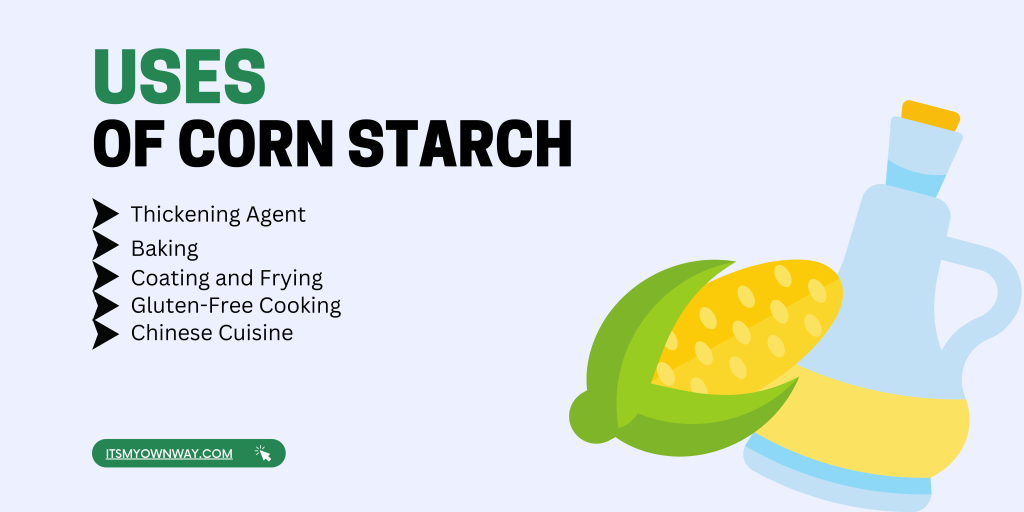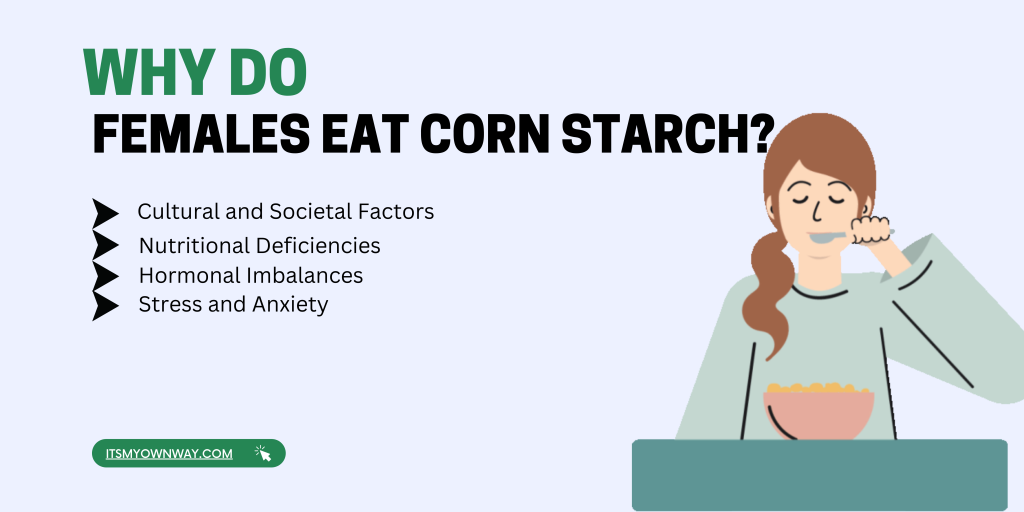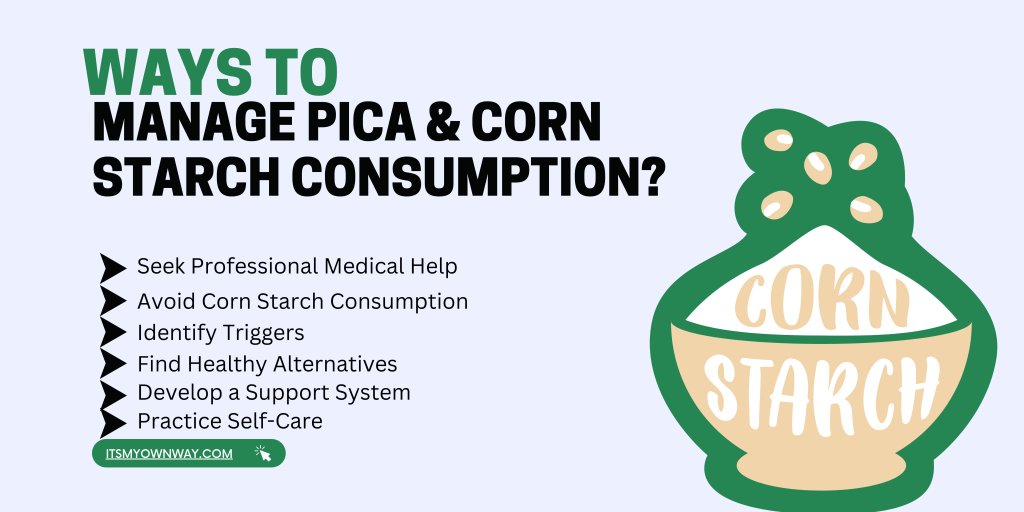Women have reportedly been known to develop cravings while using corn starch, a common thickening additive in food. The desire to eat raw corn starch is a peculiar phenomenon known as pica, which is characterized by the urge to consume non-food items. This condition affects not only women but anyone, especially those with nutritional deficiencies. In this discourse, we will explore why females crave corn starch and the potential health implications of such cravings.
Uses of Corn Starch

1. Thickening Agent
Corn starch is the most ubiquitous thickening agent employed in cooking. When mixed with liquids, it swiftly absorbs the liquid, causing it to thicken. Consequently, it is an essential ingredient in dishes like gravies, sauces, and soups. It is also used to thicken fruit pies, custards, and puddings.
2. Baking
In baking, cornstarch is frequently used as a flour substitute, especially in gluten-free recipes. Corn starch is particularly effective in creating delicate, crumbly textures in shortbread cookies and some types of cakes. Additionally, it can be used to increase the fluffiness of baked foods.
3. Coating and Frying
Corn starch is an ideal coating ingredient for frying foods, yielding a crispy and crunchy texture on the outside while keeping the inside juicy and tender. It is used to coat chicken and other meats before frying. In addition, it can substitute flour when preparing the batter for deep-fried foods.
4. Gluten-Free Cooking
Because it is derived from corn, corn starch is naturally gluten-free, making it a preferred ingredient in gluten-free cooking. It can replace flour in many recipes and is especially useful in baking, where it is employed to create delicate, crumbly textures in gluten-free cakes and cookies.
5. Chinese Cuisine
Corn starch is a typical ingredient used in Chinese cuisine as a thickening agent in soups and sauces. Additionally, it is used to cover meat and veggies before frying. Chinese cooks frequently combine cornstarch with other ingredients such as ginger and soy sauce to create delicious marinades for meat.
6. Other Uses
Corn starch has several other applications in the kitchen. For example, it can be blended with granulated sugar to create homemade powdered sugar. Additionally, it can thicken homemade yogurt and keep ice crystals from forming in ice cream.
Nutritional Value of Corn Starch
Corn starch is primarily composed of starch, a complex carbohydrate, and is low in fiber, protein, vitamins, and minerals. One tablespoon of corn starch (8 grams) contains roughly 30 calories and 7 grams of carbohydrates, with no fat or protein.
Health Effects of Eating Corn Starch
Digestive Issues
Digestion problems are among the most frequent side effects of eating maize starch. High in carbs, corn starch might be challenging for some people to digest. Bloating, gas, and stomach discomfort can result from consuming a lot of maize starch. Additionally, it may occasionally result in diarrhea or constipation.
Weight Gain
Corn starch is a high-calorie ingredient and is often used in processed foods that are high in fat and sugar. Overconsumption of corn(maize) starch, especially in processed foods, can result in weight gain and other obesity-related health issues.
Blood Sugar Imbalances
Corn starch is a high glycemic index food, which means that it can cause a rapid increase in blood sugar levels after consumption. For those with diabetes or those who need to control their blood sugar levels, this can be very difficult.
Allergies
Corn starch is a common allergen, particularly for people with a corn allergy. Symptoms of a corn allergy can range from mild to severe and may include hives, itching, swelling, and difficulty breathing.
What is Pica?
Pica is a disorder characterized by an individual’s craving for non-food substances. These substances can include but are not limited to, dirt, ice, paper, soap, hair, and cornstarch. Pica can occur in individuals with certain mental health disorders, such as autism, schizophrenia, and obsessive-compulsive disorder. Additionally, it may be linked to pregnancy and dietary deficits.
Why Do Females Eat Corn Starch?

While the exact cause of pica remains unknown, there are several theories as to why females with pica consume corn starch. These include cultural and societal factors, nutritional deficiencies, hormonal imbalances, and stress and anxiety.
1. Cultural and Societal Factors
In some cultures, the consumption of non-food substances, including corn starch, is considered normal or even desirable. For example, in some parts of Africa, clay is consumed for its medicinal properties. Similarly, some females in the southern United States consume corn starch as a snack or as a way to soothe morning sickness during pregnancy.
2. Nutritional Deficiencies
Nutritional deficiencies, particularly iron-deficiency anemia, have been associated with pica. For the creation of hemoglobin, which transports oxygen in the blood, iron is a crucial mineral. Anemia, a disorder that can result from an iron deficiency in the body, can make people feel weak, exhausted, and breathless. Some females with pica consume corn starch as a way to alleviate these symptoms.
3. Hormonal Imbalances
Pica has also been linked to hormonal imbalances, such as those that take place during menopause or pregnancy. Some females may crave non-food substances, such as corn starch, as a result of these imbalances.
4. Stress and Anxiety
Stress and anxiety can also play a role in pica. Some females may turn to non-food substances, such as corn starch, as a way to cope with stress and anxiety.
Potential Health Consequences of Eating Corn Starch
While consuming small amounts of corn starch is generally considered safe, excessive consumption can lead to several health consequences. No vitamins or minerals are present in corn starch, which is not a source of nutrition. Consuming large amounts of corn starch can lead to gastrointestinal problems, such as constipation and bowel obstruction. Nutrient shortages may result from it as well since it might prevent the absorption of nutrients like iron.
Coping Strategies for Pica
If you or someone you know has pica, there are several coping strategies that can be helpful. These include:
- Identifying and addressing any underlying mental health or medical conditions.
- Seeking professional help, such as therapy or counselling.
- Engaging in stress.
Ways to Manage Pica and Corn Starch Consumption

We understand that pica and corn starch consumption can be a challenging condition to manage. A disorder called pica causes people to consume non-food things like cornstarch, clay, chalk, or soil. This condition can be a result of various underlying medical conditions, including iron deficiency anaemia or pregnancy. In this post, we’ll look at several strategies for controlling your intake of corn(maize) starch and pica.
1. Seek Professional Medical Help
If you are struggling with pica, it is vital to seek professional medical help. The right treatment will be suggested and the underlying condition will be identified with assistance from medical professionals. They can also help you address any nutritional deficiencies that may be causing your cravings for non-food items.
2. Avoid Corn Starch Consumption
Corn starch consumption can be harmful to your body as it contains no nutritional value. Consuming cornstarch can lead to malnutrition and iron-deficiency anaemia. It’s crucial to refrain from eating cornstarch if you have pica. Try to satisfy your urges with healthier options instead.
3. Identify Triggers
Determine Triggers You can better control the disease by recognizing the causes that result in desires for pica. Some common triggers include stress, boredom, and anxiety. Once you’ve recognized the triggers, make every effort to stay away from them. You can also satisfy your cravings for pica with wholesome foods like fruits, veggies, or nuts.
4. Find Healthy Alternatives
If you have pica cravings, it is important to find healthy alternatives to satisfy them. For example, if you crave ice, you can substitute it with a cold glass of water. If you crave non-food items such as clay, dirt, or chalk, you can try using gum, mints, or candy to satisfy your cravings.
5. Develop a Support System
Managing pica cravings can be challenging, and it is essential to have a support system. Your support system can be your family, friends, or professional counsellor. Your support system can help you stay on track with your treatment plan and provide emotional support during challenging times.
6. Practice Self-Care
Practicing self-care can help manage pica and corn starch consumption. Self-care practices such as regular exercise, meditation, and getting enough sleep can help reduce stress and anxiety, which are common triggers for pica cravings.
By following these strategies, you can manage pica and corn starch consumption effectively.
Treatment options for pica
There are various treatment options available for pica, depending on the underlying cause and severity of the disorder. Here are some of the most commonly used treatment options:
1. Address Nutritional Deficiencies
Nutritional deficiencies, such as iron-deficiency anemia, are a common cause of pica. Iron supplements or an iron-rich diet can help correct the deficiency, which may help reduce cravings for non-food items.
2. Behavioral Therapy
Behavioral therapy is a type of therapy that aims to modify behaviour by identifying and changing negative thought patterns. Behavioral therapy for Pica might assist in addressing underlying emotional or psychological problems that may be causing the illness.
3. Medication
In some cases, medication may be used to treat pica. Some people’s symptoms of pica have been proven to be improved by medications such selective serotonin reuptake inhibitors (SSRIs).
4. Alternative Therapies
Some alternative therapies may be used to treat pica, such as acupuncture, massage therapy, and chiropractic care. These treatments work to increase calmness and lessen stress, which may help lessen cravings for things other than food.
5. Environmental Modification
The environmental modification involves making changes to the individual’s environment to reduce access to non-food items. For example, if an individual is craving clay or dirt, their environment may be modified to remove access to these substances.
6. Support Groups
Support groups can be beneficial for people with pica because they offer a safe space for people to talk about their experiences and receive emotional support.
Alternatives to Corn Starch
There are numerous alternatives to corn starch for those who are searching for them. Arrowroot starch, tapioca starch, and potato starch are all alternatives to corn starch and can be used in the same way.
Arrowroot starch is a root vegetable that is native to South America. It is high in fibre and contains some potassium, iron, and vitamin B6. Tapioca starch is made from the cassava plant and is also high in carbohydrates. Potato starch is made from potatoes and is similar in nutritional value to corn starch.
Conclusion
The craving for corn starch among females may seem strange, but it’s a phenomenon that has been reported by many individuals. While it can be caused by a range of factors such as nutritional deficiencies, pregnancy, stress, and cultural and social factors, it’s important to remember that eating non-food items can be dangerous and lead to health complications. It’s critical to get medical assistance and address the underlying causes of the need if you or someone you know has pica. Remember that eating a well-balanced, nutritious diet is essential for sustaining excellent health and that there are many delicious, healthy alternatives available to satiate your cravings.
Frequently Asked Questions
Is it safe to eat corn starch?
Starchy meals are more prone to stick in your teeth, and while it may not seem like it, crunchy foods can result in shattered teeth.
What happens if you eat cornstarch everyday
Regularly consuming large amounts may raise blood sugar levels and have detrimental consequences on heart health.










